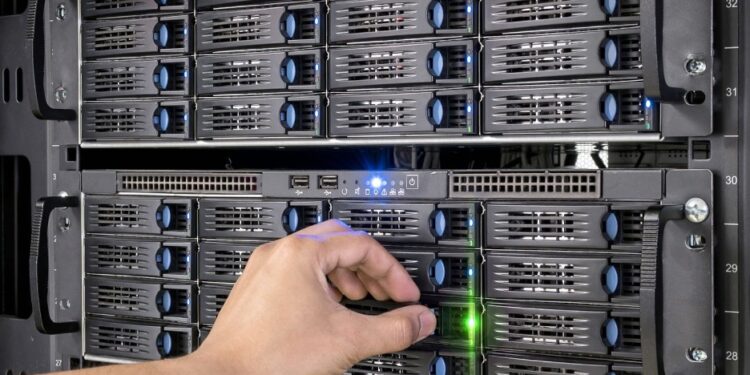In the world of business IT, there’s a legacy model that has long been a source of inefficiency and cost: “one server, one application.” This approach leads to a phenomenon known as “server sprawl,” where an organization ends up with a chaotic collection of underutilized physical servers, each running a single service and consuming vast amounts of power, space, and management resources. The modern solution to this problem is not to buy more servers but to buy fewer, more powerful ones and harness the transformative power of server virtualization.
Server virtualization is a technology that allows you to run multiple independent, isolated virtual servers on a single physical machine. It’s the cornerstone of modern IT infrastructure and the fundamental technology that powers the entire cloud computing revolution. By adopting virtualization, businesses can dramatically reduce their hardware footprint, cut operational costs, and gain an unprecedented level of flexibility, scalability, and resilience.
This comprehensive guide will serve as your definitive resource on server virtualization. We will demystify the core concepts, explore the overwhelming business case for making the switch, review the major players in the virtualization ecosystem, and provide a strategic roadmap for a successful migration. Our goal is to equip you with the knowledge to not only understand virtualization but to implement it as a critical strategy for future-proofing your business.
What is Server Virtualization?

At its heart, server virtualization is a form of abstraction. It’s the process of decoupling the hardware from the software, allowing a single physical server to act as a host for many independent virtual servers, each with its own operating system and applications. A simple analogy is an apartment building:
- The physical host server is the building itself.
- The hypervisor is the building manager, responsible for allocating and managing resources like electricity, water, and space.
- Each virtual machine (VM) is an individual apartment, a self-contained unit with its own tenant (operating system) and furnishings (applications).
The key components of this architecture are:
A. The Physical Host Server: This is the underlying, high-performance physical machine. It contains the raw power—the CPU, RAM, storage, and networking—that is shared among all the virtual machines. It is the foundation of your virtualized environment.
B. The Hypervisor (Virtual Machine Monitor): This is the crucial software layer that makes virtualization possible. The hypervisor creates and manages the virtual machines, acting as an intermediary between the VMs and the physical hardware. It allocates and schedules resources, ensuring that each VM receives the necessary CPU time, memory, and storage without interfering with its neighbors. There are two main types of hypervisors:
- Type 1 (Bare-Metal) Hypervisor: This hypervisor is installed directly on the physical server hardware. It has direct access to the hardware and is therefore highly efficient and secure. This is the preferred choice for enterprise environments and data centers. Examples include VMware ESXi and Microsoft Hyper-V.
- Type 2 (Hosted) Hypervisor: This hypervisor runs as an application on top of a host operating system (e.g., VirtualBox running on Windows or macOS). It is less efficient because it has to go through the host OS to access the hardware, but it is useful for testing, development, and personal use.
C. The Virtual Machine (VM): This is the self-contained, virtual server. Each VM is a complete, isolated environment with its own virtual hardware (vCPU, vRAM, virtual disks) and its own operating system (e.g., Windows Server, Ubuntu Linux, CentOS). It functions exactly like a physical server but exists purely in software.
The Unbeatable Business Case for Virtualization
The move to a virtualized infrastructure is not just a technical trend; it’s a strategic business decision that delivers massive returns on investment.
A. Massive Cost Savings:
- Reduced Hardware Costs: Instead of buying a new physical server for every new application, you can simply create a new VM on an existing host. This dramatically reduces capital expenditure.
- Lower Operational Costs: Fewer physical servers mean less power consumption, less cooling, and a smaller physical footprint. This translates directly to a lower Total Cost of Ownership (TCO).
B. Unprecedented Resource Optimization:
In the old model, servers were often underutilized, with a single physical machine using only 10-15% of its CPU and RAM. Virtualization solves this by allowing you to consolidate dozens of underutilized physical servers onto a handful of powerful virtual hosts, maximizing the use of your hardware and eliminating “server sprawl.”
C. Enhanced Agility and Scalability:
- Rapid Provisioning: Creating a new physical server can take days or weeks. With virtualization, you can provision a new VM in a matter of minutes, allowing your IT team to respond to business needs with unprecedented speed.
- Easy Scalability: If a VM needs more resources, you can easily add more vCPU, vRAM, or virtual disk space without any physical hardware changes, providing incredible flexibility to meet changing demands.
D. Simplified Disaster Recovery and Business Continuity:
- Virtual Machine Mobility: A virtual machine is just a set of files on a disk. This makes it incredibly easy to back up, replicate to an offsite location, or move to a different host in the event of a hardware failure.
- Faster Recovery Times: In the event of a disaster, you can restore your VMs to new hardware or to a cloud environment in a fraction of the time it would take to restore a physical server.
E. Improved Security:
Virtual machines are isolated from each other. If one VM is compromised by malware, the malware is contained within that VM and cannot spread to the host or other VMs. This provides an important layer of security and containment.
F. Streamlined Management:
Virtualization management platforms provide a centralized dashboard for managing your entire virtualized environment. A single administrator can now easily monitor, manage, and provision dozens of servers, freeing up time to focus on strategic initiatives.
The Virtualization Ecosystem
The hypervisor is the heart of your virtualized environment. Choosing the right one depends on your budget, technical expertise, and existing IT infrastructure.
A. VMware:
VMware is the undisputed industry leader and a gold standard for enterprise virtualization. Its flagship product, vSphere, is a robust, feature-rich platform used by companies of all sizes.
- Strengths: Unmatched stability, a vast ecosystem of third-party tools, advanced features like vMotion (live migration of a VM from one host to another without downtime), and comprehensive support.
- Best For: Large enterprises, mission-critical applications, and organizations with a significant budget for licensing and support.
B. Microsoft Hyper-V:
Hyper-V is Microsoft’s native hypervisor, which comes included with Windows Server.
- Strengths: Seamless integration with the Microsoft ecosystem, including Active Directory, System Center, and Azure. Its cost-effectiveness makes it a compelling choice for businesses that are already heavily invested in the Microsoft stack.
- Best For: Small to medium-sized businesses and organizations that primarily use Windows-based applications and want to virtualize their servers without a significant additional investment.
C. Proxmox VE:
Proxmox is a free and open-source hypervisor that has gained immense popularity, particularly among small businesses and home users.
- Strengths: Completely free, offers both VM and container support in a single platform, and has a user-friendly web interface.
- Best For: Small businesses, home labs, and users who want a powerful and flexible virtualization platform without any licensing costs.
D. Other Players:
Other notable hypervisors include Citrix XenServer and the open-source KVM, which is a core component of many Linux distributions and is used by major cloud providers like Google and Amazon.
The Strategic Planning

The migration from a physical to a virtualized infrastructure requires careful planning to ensure a smooth transition with minimal disruption.
A. The Initial Assessment:
Before you migrate, you need to audit your existing physical servers.
- Application and Workload Analysis: Identify what applications are running on each server and how much CPU, RAM, and storage they actually use.
- Server Health Check: Look for any potential hardware or software issues that could cause problems during the migration.
- P2V (Physical to Virtual) Candidate Identification: Not all servers are good candidates for virtualization. Identify which ones can be migrated and which ones should remain physical due to specific hardware or performance requirements.
B. Hardware Sizing and Selection:
This is the most critical step. Your virtualized host server must have enough power to accommodate all the VMs you plan to run.
- Over-Provisioning: It is a best practice to over-provision your host server’s resources. For example, if your VMs require a total of 64GB of RAM, your host should have at least 96GB or more to account for the hypervisor’s overhead and future growth.
- Server-Grade Hardware: For a virtualization host, you must use server-grade hardware, including CPUs that support virtualization (e.g., Intel VT-x or AMD-V), ECC (Error-Correcting Code) RAM for data integrity, and a RAID array for storage redundancy.
C. The Migration Process:
The process of moving a physical server to a virtual one is known as Physical to Virtual (P2V) migration.
- Use P2V Tools: Hypervisors come with tools that can automate the P2V process. These tools take an image of your physical server and its operating system and convert it into a virtual disk file that can be run on the hypervisor.
- Testing and Validation: After the migration, thoroughly test the new VM to ensure all applications and services are working as expected.
Advanced Virtualization and the Future
Virtualization is not a final destination; it is a stepping stone to a more flexible and agile IT infrastructure.
A. Containerization (Docker and Kubernetes):
Containers are a more lightweight form of virtualization that package an application and all its dependencies into a single, portable unit. While VMs virtualize the entire server, containers virtualize the application layer. They can be used on top of a hypervisor to provide an even greater level of agility and resource efficiency.
B. Virtual Desktop Infrastructure (VDI):
VDI is the virtualization of a user’s desktop environment. It allows you to host all of a company’s desktops and applications on a centralized server or a cloud service. This simplifies management, enhances security, and provides users with secure access to their desktop from any device.
C. The Hybrid Cloud:
The ultimate goal for many businesses is a hybrid cloud strategy, where they use a combination of on-premise virtual servers and a public cloud. Virtualization is the foundation for this strategy, as it makes it easy to migrate VMs from your data center to a cloud provider like Microsoft Azure or Amazon Web Services (AWS) and back, providing unparalleled flexibility.
Conclusion
In the modern IT landscape, server virtualization is no longer a luxury but a strategic necessity. It represents a fundamental shift away from the wasteful and inefficient model of “server sprawl” toward a smart, agile, and cost-effective infrastructure that is built for longevity. By embracing virtualization, you are not just consolidating servers; you are transforming your IT from a reactive cost center into a proactive engine for innovation and growth.
The business case for virtualization is overwhelming and impossible to ignore. From the massive cost savings on hardware, power, and cooling to the unprecedented gains in resource utilization and operational efficiency, the return on investment is clear and compelling. The ability to provision new servers in minutes, scale resources on the fly, and recover from disasters with minimal downtime provides a level of business agility that is simply unattainable in a traditional physical environment. Furthermore, the enhanced security and streamlined management that come with virtualization allow your IT team to focus on strategic initiatives rather than day-to-day administrative tasks.
Ultimately, the power of virtualization lies in its ability to abstract complexity. By decoupling applications from the underlying hardware, you are building an IT infrastructure that is resilient, portable, and future-proof. Whether you are running a small family business or a global enterprise, the move to a virtualized environment is the single most important step you can take to ensure your technology is not just supporting your business but is actively empowering it to thrive in a rapidly changing digital world.









